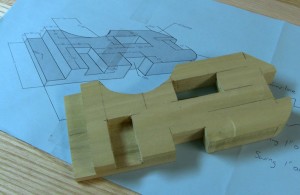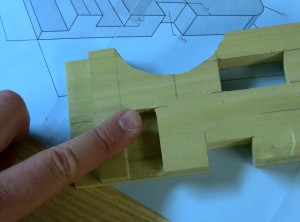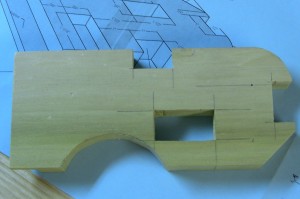Gott Woodworking Exercises?
 Last night’s Hand Tool School demo was a great success. I’m proud to say that my attempt at the Gottshall Block went off really well. No blood was spilled and I didn’t utter any political career ending gaffes. Although some would say that without blood spillage it was not a good demo. I promise next time I will channel my inner Underhill.
Last night’s Hand Tool School demo was a great success. I’m proud to say that my attempt at the Gottshall Block went off really well. No blood was spilled and I didn’t utter any political career ending gaffes. Although some would say that without blood spillage it was not a good demo. I promise next time I will channel my inner Underhill.
 My block came out great. Everything was square and flat and where it should be. I need to send it off to the Gottshall Block of America Ratings and Grading Institute to get my official score, but I’m confident that I earned a passing grade. I did have a fouled corner on the “gain” or stopped dado caused when my chisel wasn’t aligned properly while chopping down the back wall, but other than that, everything looks good and matches the measurements of the original drawing.
My block came out great. Everything was square and flat and where it should be. I need to send it off to the Gottshall Block of America Ratings and Grading Institute to get my official score, but I’m confident that I earned a passing grade. I did have a fouled corner on the “gain” or stopped dado caused when my chisel wasn’t aligned properly while chopping down the back wall, but other than that, everything looks good and matches the measurements of the original drawing.
**Does anybody know the origin of the joint name “gain” that is used here? That is a new one to me and I wonder if it is a regional term**
So thank you again to everyone who came out to watch. I did the stock prep and layout off camera prior to starting the broadcast and I would guess that took me about an hour. The cutting of the joinery was just proud of another hour so this entire “project” is a really great afternoon in the shop skill building exercise. The blessing and the curse of this whole thing is that errors beget errors. The layout is done by referencing off the last element so if you misplace a line now, it will throw off your subsequent lines. Sticking to the tools that Gottshall uses in his text makes this an exercise in chisel control more than anything. Certainly sawing prowess is tested in a few areas too but refining the elements to a line with a chisel is where the rubber meets the road. So in that sense, now that I have completed the block, I consider this to be a really great exercise for anyone to try. The mixture of bevel up and bevel down chisel work and honing the ears and eyes to listen and watch for a flat surface is invaluable.
The tools used for this are as follows:
- Dividers
- Marking Gauge
- Marking Knife
- Carcass Saw
- 11/16 or 5/8 Drill
- Coping Saw (my Knew Concepts Saw made this part really easy)
- Assorted Chisels (I used 3/4, 1, and 1/4″)
- Block Plane (this wasn’t necessary and doing without would increase the chisel handling)
An interesting point brought up in the chat room was how this exercise might differ if the tools were not limited to just chisel and saw. For instance, the gain could be quickly refined with a router plane. The rabbet could be quickly cut and refined with a rabbet plane. I think the consensus is that the end result may NOT be as good as doing it without. A chisel gives you greater flexibility to remove a little wood here or there even more so than a plane. So while this exercise feels more “free hand” the results are better doing it that way. It could be an interesting test to try and speed this up by using specialty tools. I’ll wait until I have nothing else to do and then maybe give that a try.
Even though there is no tenon or dovetail on this block the elements of those joints are represented. After all isn’t a rabbet also a tenon cheek and shoulder? A dado on the end of a board is just like a dovetail pin. In essence the 8 elements that you cut into the block really represent a reduction of all possible joinery into a series of saw and chisel cuts. Additionally the Gottshall block forces you to work with an accuracy that usually isn’t necessary in most furniture projects, so after completing it your next project will seem much easier.
Overall I was really happy how my block came out and the experience was a good one. Special thanks to Bob Lang of Popular Woodworking for reintroducing this exercise to the masses. I for one am going to look for more of these kinds of exercises to try to hone my skills. If any of you know exercises like this please leave a comment below and share it. These are the elements that many of us are missing with no more shop classes and the death of the apprentice system and they can make us all better woodworkers without using up a lot of wood or time.



